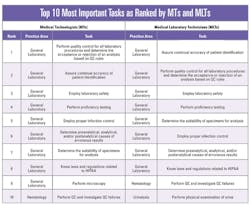American Medical Technologists (AMT) develops certification examinations for various occupational specialties in the medical field, spanning diverse allied health roles on a care team. An essential component to criterion-referenced certification exams is the relationship of test items to competent performance.1 The test blueprint used to construct a certification examination must be representative of the knowledge and skill required for entry level practice. Therefore, criterion-referenced certification examinations must rely on empirical job or task analysis of current practitioners to construct their blueprints. AMT regularly conducts task analysis studies every five to seven years in order to ensure its exam specifications and content align with current practice in the various fields. The objective and overall goal of the Medical Technologist (MT)/Medical Laboratory Technician (MLT) job task analysis was to identify the critical tasks involved in performing the job functions of an MT/MLT and bring the MT/MLT test specifications more closely into alignment with practice in the MT/MLT field. This article is a report of the most recent such analysis, based on two recently completed surveys.
Survey methodology
A committee of subject matter experts refined a set of 171 task statements that were derived from skills and knowledge areas linked to the MT/MLT practice role. These 171 statements were organized into eleven content areas (General Laboratory, Chemistry, Hematology, Coagulation and Hemostasis, Immunology and Serology, Immunohematology, Blood Banking, Bacteriology, Mycology, Parasitology, and Urinalysis) with multiple statements in each content area ranging in number from three to 47.
In order to validate the results, two different surveys were conducted. Each survey questionnaire, along with several demographic questions, was mailed to a random representative sample of 650 MTs and 650 MLTs employed in the United States.
- The “Importance” survey: this survey utilized an importance scale, where practitioners in the field were asked to rate the importance of each task to their current job role. The survey respondents were asked to assign ratings based on a five-point Likert type scale ranging from 0 (Of No Importance) to 4 (Of Great Importance).
- The “Percentage of Time” survey: this survey asked practitioners to specify the amount of time (in percent) they spend within each of the defined major practice areas that encompass clinical laboratory duties. This survey also included an “other” category to give participants an opportunity to specify another practice area in the event they felt part of their job was spent outside the categories that were defined.
Survey samples demographics and response rates
The respondent group consisted of 228 MTs and 185 MLTs for the “Importance” survey and 169 MTs and 113 MLTs for the “Percentage of Time” survey. Both the MT and MLT samples from the two surveys were diverse and had a good representation across all the demographic variables. Many variables show highly similar distributions by type of practitioner, with some notable exceptions consistent with the field’s definition of the different job roles.
Most notably, the expected sizable differences in education between MTs and MLTs was observed. MTs were much more likely to have a bachelor’s degree (59 percent versus 26 percent), to have been in the field for more than 20 years (52 percent versus 31 percent), and to represent an older age group, over 46 years of age (60 percent versus 46 percent), than their MLT counterparts.
The response rates were relatively high for both MTs and MLTs on the “Importance” survey—37 percent and 29.4 percent respectively. A typical response rate for these types of verification surveys is 10 percent to 35 percent. Although the response rates for the “Percentage of Time” survey were surprisingly lower, they were still on the higher end at 28.9 percent for MTs and 19.7 percent for MLTs.
Individual task importance ratings
In order to evaluate each task’s importance to the role of an MT/MLT practitioner and its relevance in the MT/MLT test blueprint, the ratings were condensed and converted to a linear scale. High values indicated tasks that were regarded as highly important to the job role, and low values indicated tasks that were thought to be less important to the job role. Tasks were then ranked from 1 to 171, with 1 representing the most important task. The importance rankings were also transformed to relative percentages of weight, and these task weight percentages were collapsed across the larger practice areas to construct content weights for the test blueprint.
On the whole, the results of the “Importance” ratings indicate that practitioners felt most tasks were of high importance to the job role of an MT and MLT, where ratings were consistently high across many of the task items. Only two practice areas were represented in the top 10 most important tasks for MTs, and only three practice areas for MLTs. Of those rated as the most important, the majority came from the general laboratory practice area. A wider representation of practice areas appeared among the ten tasks rated as least important. These included Chemistry, Coagulation and Hemostasis, Hematology, Immunohematology, Immunology and Serology, Mycology, and Parasitology.
As a result, these low task importance ratings transformed to weight percentages of 0 percent or less. Any tasks that yielded no weight were flagged and recommended for review by our subject matter expert committee for revision or possible removal from future test specifications. For the sake of brevity, Tables 1 and 2 highlight the top 10 MOST important and the top 10 LEAST important tasks for both MTs and MLTs.
Amount of time spent in laboratory practice areas
The results of the “Percentage of Time” survey were intended to verify the content weight breakdown derived from the “Importance” survey. For the “Percentage of Time” survey, means and standard deviations for the numerical percentages in each of the practice areas were computed. The percentage breakdowns allocated to each of the practice areas were used to compare and verify the content weights that the “Importance” survey produced.
Overall, the percentage of time spent in each practice area as allocated by MT and MLT practitioners coincided with the content weight percentages calculated from their task importance ratings. Both MTs and MLTs spent the most amount of time in the Chemistry and Hematology practice areas (about 20 percent of total time in each area). The least amount of time was spent in the Mycology and Parasitology practice areas for both groups (about one percent in each for MTs and less than one percent each for MLTs). The eleven practice areas presented in the survey accounted for a considerable amount of both MT and MLT practitioner time. The two groups indicated that these practice areas represented over 97 percent of their clinical lab time.
There were also some notable differences between the importance and time spent for a few of the practice areas. For example, both MT and MLT practitioners indicated that they spend over eight percent of their time in the Immunology and Serology practice areas; however, their importance ratings for those tasks suggest a content weight of less than four percent. The “Percentage of Time” survey also included an “Other” practice area category not represented in the “Importance” survey. This might have contributed to some of the discrepancy in a few of the areas. “Other” practice areas reported for MTs included phlebotomy, mycobacteriology, molecular diagnostics, cytogenics, virology, teaching, and supervisor/management duties. MLTs indicated “other” practice areas such as phlebotomy, molecular biology and pathology, toxicology, paperwork, and management duties.
Conclusion
In job or task verification analyses, current practitioners evaluate the generation or the revision of tasks or knowledge areas by providing ratings of importance, frequency, and/or other rating dimensions for each element.2 The feedback AMT received from the MT/MLT community is valuable as it keeps the organization up to date on the present state of practice and any recent changes that may have occurred, and aids its efforts to update and restructure the exam content accordingly. The results of this task analysis highlighted both the differences and similarities in the MT and MLT job roles.
Overall, for both MTs and MLTs, the results from the two surveys suggest a decrease in content coverage for the Immunohematology, Bacteriology, and Urinalysis content areas and an increase in the Hematology content area. In addition, the two surveys revealed inconsistent content weights for the Blood Banking area for both MTs and MLTs. The “Importance” survey suggested a decrease in coverage, but the “Percentage of Time” survey suggested a weight similar to the Blood Banking weight currently on the exam.
Last, the results of the two surveys also suggested a decrease in the Immunology and Serology content area for MTs and an increase in the Coagulation and Hemostasis content area for MLTs. Altogether, the largest discrepancy for both MTs and MLTs include the Blood Banking, Immunohematology, and Immunology and Serology content areas. Thus, the survey compilers made the recommendation to AMT’s subject-matter experts to pay close attention and possibly revise the tasks and content weights within these subsections.
References
- Lunz M, Stahl J, James K. Content validity revisited: Transforming job analysis data into test specifications. Evaluation and the Health Professions.1989;12(2):192-206.
- Tannenbaum R J, Wesley S. Agreement between committee-based and field-based job analyses: A study in the context of licensure testing. Journal of Applied Psychology. 1993;78(6):975-980.




